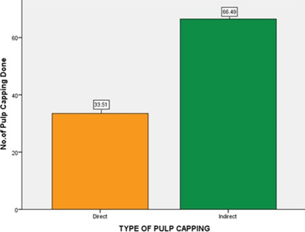Abstract
The aim was mainly to determine the correlation between the type of pulp capping method and the material of choice in this study. Pulp capping in the carious teeth has been considered as unpredictable and they mainly have a lesser success rate. The pulp capping can be mainly done in two methods; they are direct and indirect pulp capping, which can be mainly done with the help of different materials of choice like calcium hydroxide, MTA etc. The study was conducted in Saveetha Dental College. The data collection has been done from the department of Conservative dentistry and Endodontics for patients undergoing pulp capping treatment. The results were obtained and tabulated, the type of pulp capping method was 67% of indirect pulp capping and 33% of direct pulp capping method in which 81% of calcium hydroxide, 8% of MTA and 11% of RMGIC were used as the materials of choice. Among which indirect pulp capping method was most commonly used than the direct pulp capping method with calcium hydroxide as the material of choice for the treatment (p < 0.05, which is statistically significant). The pulpal exposure was mainly due to dental caries and mechanical preparation of the tooth. Within the limits of the present study, the most common type of the pulp exposure was due to dental caries and mechanical exposure during the cavity preparation of the tooth and the most common method of pulp capping was the indirect method with calcium hydroxide (CaOH) as the most common material of choice.
Full text article
Authors

This work is licensed under a Creative Commons Attribution-NonCommercial-NoDerivatives 4.0 International License.

